The 4-6-6-4 "Challenger": Another UP-Inspired Design
Last revised: November 4, 2024
By: Adam Burns
The Challenger Type, characterized by its articulated design, stands as one of the most successful large wheel arrangements in history.
This engineering marvel was initially developed for Union Pacific in their quest to build a more powerful locomotive capable of hauling significant loads over steep grades at greater speeds.
The railroad, foreseeing the potential of this design, expanded its fleet to include an impressive 105 Challengers. These 4-6-6-4s were among the technological pinnacles of their era, blending high horsepower with efficient operations to redefine locomotive performance standards.
Despite their advanced capabilities and critical acclaim, the big engines - much like their Yellowstone counterparts - experienced a relatively brief operational lifespan, marking a poignant chapter in the history of steam railroading.
Most of these impressive locomotives were decommissioned after less than twenty years of service—a few even before reaching their first decade. Throughout their operational years, they graced the tracks of nine different railroads.
However, the legacy of the Challenger was not completely lost to history. From 1981 to 2011, enthusiasts and historians had the unique opportunity to experience one of these iconic locomotives in action.
Union Pacific #3985, miraculously preserved, served not only as a moving museum piece but also as an active participant in railroading. Alongside its contemporary, 4-8-4 #844/4, #3985 was a star attraction, pulling excursion and business trains across the UP system, allowing new generations to witness a bygone era of steam railroading.
With the acquisition and restoration of "Big Boy" #4014, the venerable #3985 was retired once more. However, it was not destined to remain silent in the annals of railroading. Housed within the historic environs of the Cheyenne, Wyoming roundhouse, #3985 was poised for a resurgence.
On April 28, 2022, it was announced this iconic locomotive would be donated to the Railroading Heritage of Midwest America. This esteemed non-profit organization is headquartered in the former Rock Island shops in Silvis, Illinois, and is also responsible for operating the celebrated Milwaukee Road 4-8-4 #261.
With plans to conduct a full overhaul, the organization aims to breathe new life into #3985, preparing it to grace the rails once again in excursion service. This initiative ensures that the Challenger will continue to enchant and educate future generations about the golden age of steam railroading.
Photos
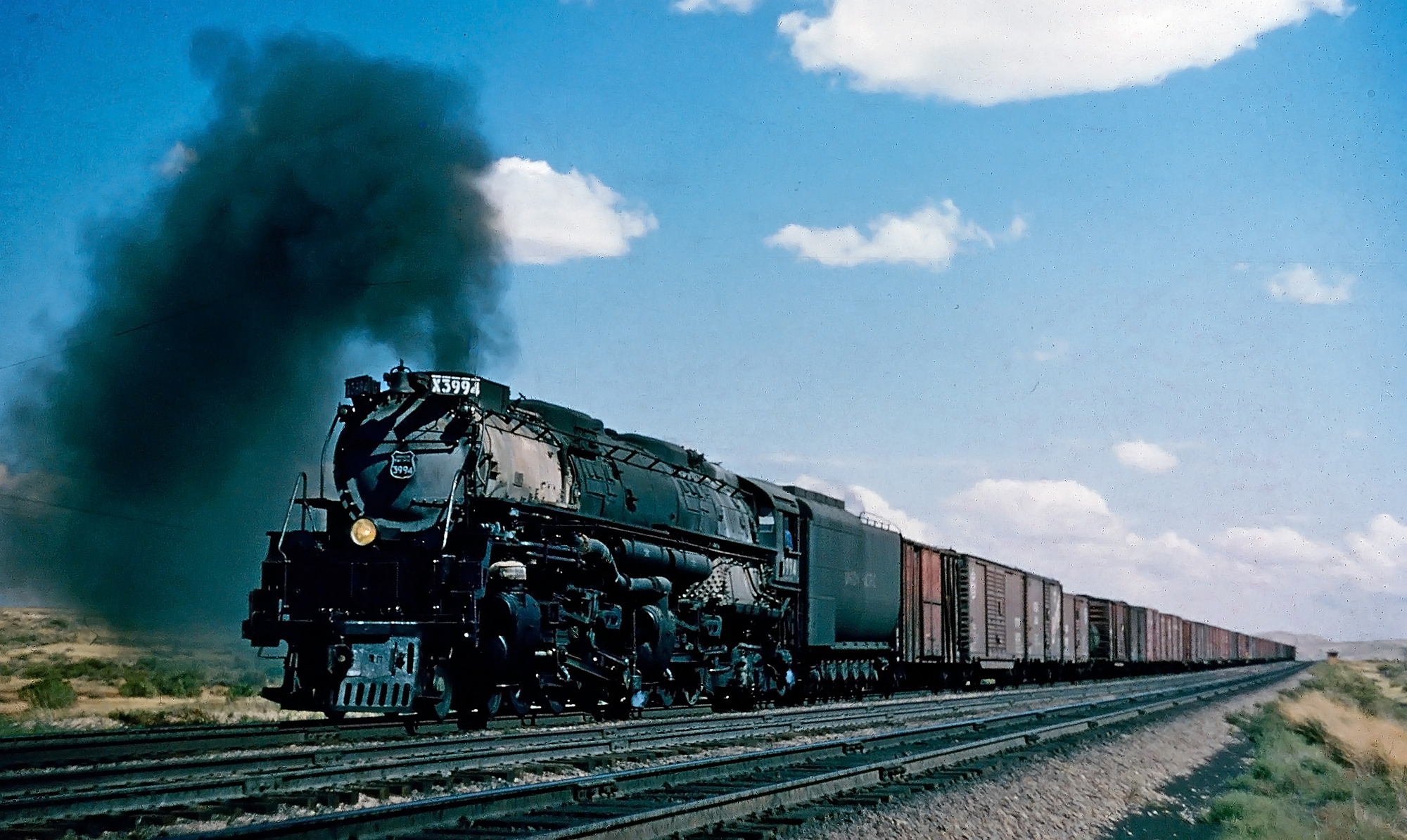 Union Pacific 4-6-6-4 #3994 is seen here in service near Kimball, Nebraska in August, 1956. Jim Hinkhouse photo. American-Rails.com collection.
Union Pacific 4-6-6-4 #3994 is seen here in service near Kimball, Nebraska in August, 1956. Jim Hinkhouse photo. American-Rails.com collection.History
The genesis of the Challenger was driven by UP's need for a more powerful locomotive that could efficiently manage the arduous demands of hauling trains across the formidable slopes of the Wasatch Mountain Range in western Utah.
During the mid-1930s, UP's Chief Mechanical Engineer Arthur H. Fetter and Assistant General Superintendent of Motive Power, Otto Jabelmann, felt that their existing fleet—notably 4-12-2 Overlands, 2-8-8-0s, and 2-10-2s—were increasingly inadequate for the evolving challenges of modern rail transportation.
This realization spurred the innovative development of the Challenger, marking a significant leap forward in locomotive design and capability.
Development
In collaboration with American Locomotive (Alco), Fetter and Jabelmann conceived the 4-6-6-4 wheel arrangement. This design emerged as an outstanding fusion of power and agility, excellently suited to meet the rigorous demands of UP's operational needs.
Arthur H. Fetter, a notable figure for his substantial contributions to advancements and innovations within UP's steam program, played a pivotal role in this development.
With the introduction of the Challenger, he championed an articulated design that not only attained higher speeds than the existing 4-12-2s but also successfully minimized the reciprocating weight, a critical factor that enhanced the locomotive's efficiency and performance.
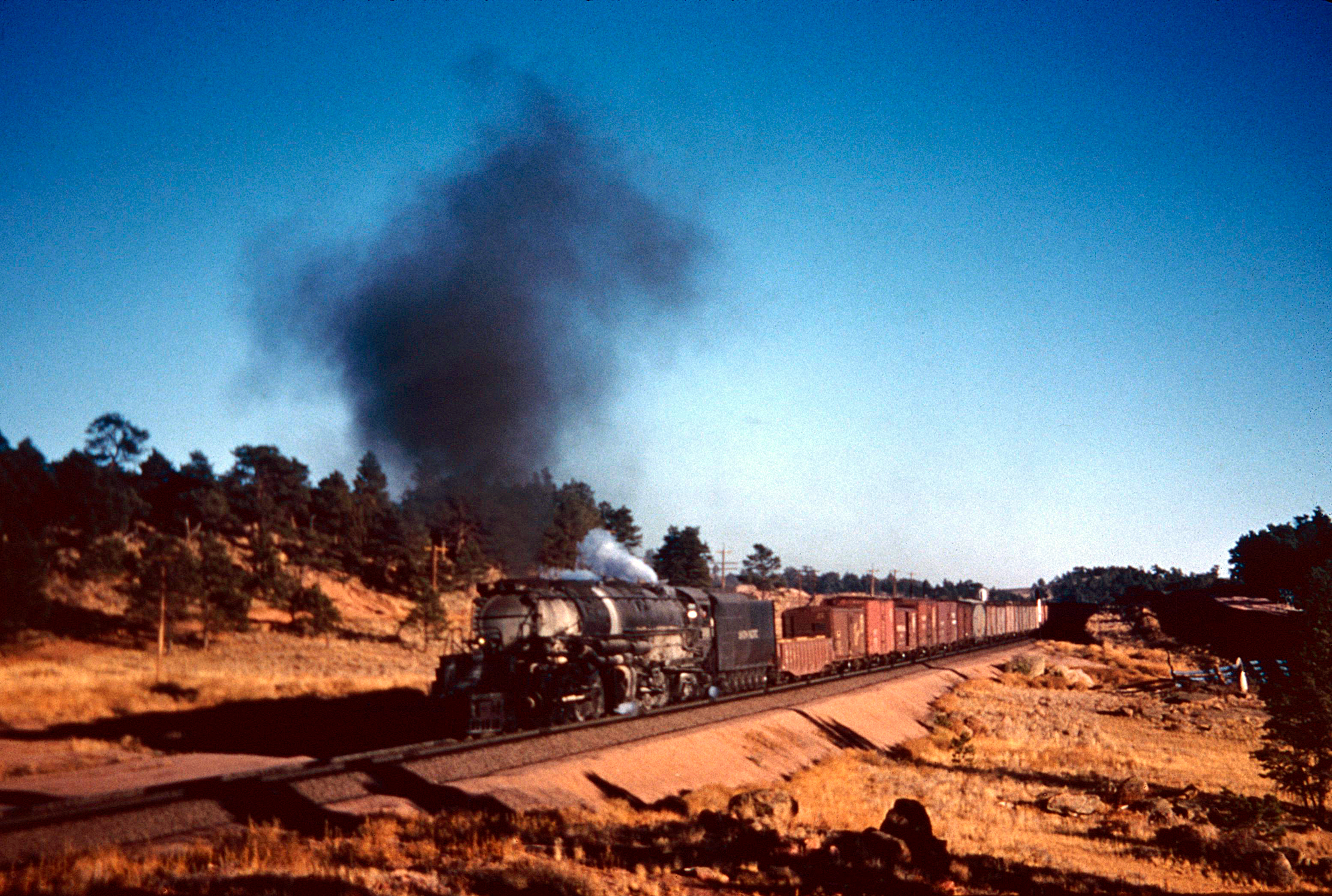 Union Pacific 4-6-6-4 #3986 steams west at Harriman, Wyoming on a summer evening in 1954. American-Rails.com collection.
Union Pacific 4-6-6-4 #3986 steams west at Harriman, Wyoming on a summer evening in 1954. American-Rails.com collection.Fetter and Alco began with an Overland design. The first prototype - #3900 - was ready for service on August 25, 1936, arriving in Council Bluffs, Iowa that day.
The 4-6-6-4 represented the zenith of steam locomotive innovation. It was equipped with state-of-the-art features including roller bearings on all axles—both engine and tender—a massive boiler, and a sizable firebox. These technological advancements made the Challenger not just a marvel of its time but also one of the most sophisticated steam locomotives ever constructed.
The inaugural test run of the new engine was an ambitious trek: it led an eastbound freight from Ogden, Utah to Green River, Wyoming, traversing the formidable Wasatch Range.
In a bold move to gauge the full capabilities of the new 4-6-6-4, officials decided to let the locomotive operate the round trip unassisted. Its performance during this rigorous test exceeded expectations, decisively proving its value and operational efficacy.
According to William Kratville's book "The Challenger Locomotives" Fretter, himself, stated the locomotive had "met the challenge" of the test and the name stuck.
In the succeeding years UP discovered these locomotives were extraordinarily versatile. Equally adept at hauling heavy, speedy freight trains over the challenging Wasatch and Sherman grades, they also excelled at propelling important passenger services.
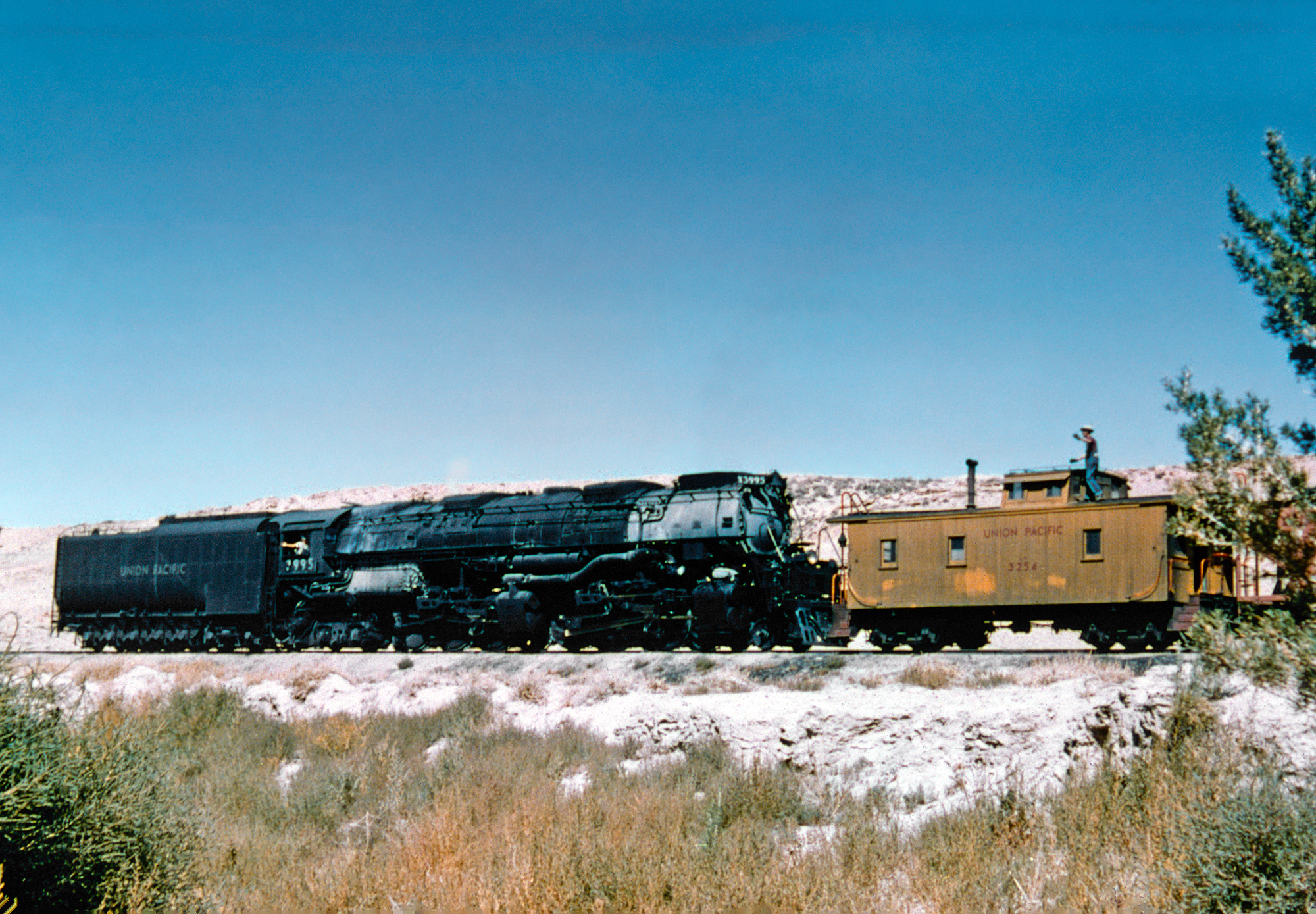 Union Pacific 4-6-6-4 #3995 switches the Winton Branch (Wyoming) on September 3, 1955. J.E. Shaw photo. American-Rails.com collection.
Union Pacific 4-6-6-4 #3995 switches the Winton Branch (Wyoming) on September 3, 1955. J.E. Shaw photo. American-Rails.com collection.Operators
- Clinchfield: Class E1 (8), E2 (4), E3 (6) – 18
- Delaware & Hudson: Class J – 40
- Denver & Rio Grande Western: Class L-105 (15), L-97 (6) – 21
- Great Northern: Class Z-6 – 2
- Spokane, Portland & Seattle: Class Z-6 (6), Z-8 (2) – 12
- Northern Pacific: Class Z-6/Z-7/Z8 - 47
- Union Pacific: Class CSA-1 (15), CSA-2 (25), 4664-3 (20), 4664-4 (25), 4664-5 (20) – 105
- Western Maryland: Class M-2 – 12
- Western Pacific: Class M-100 - 7
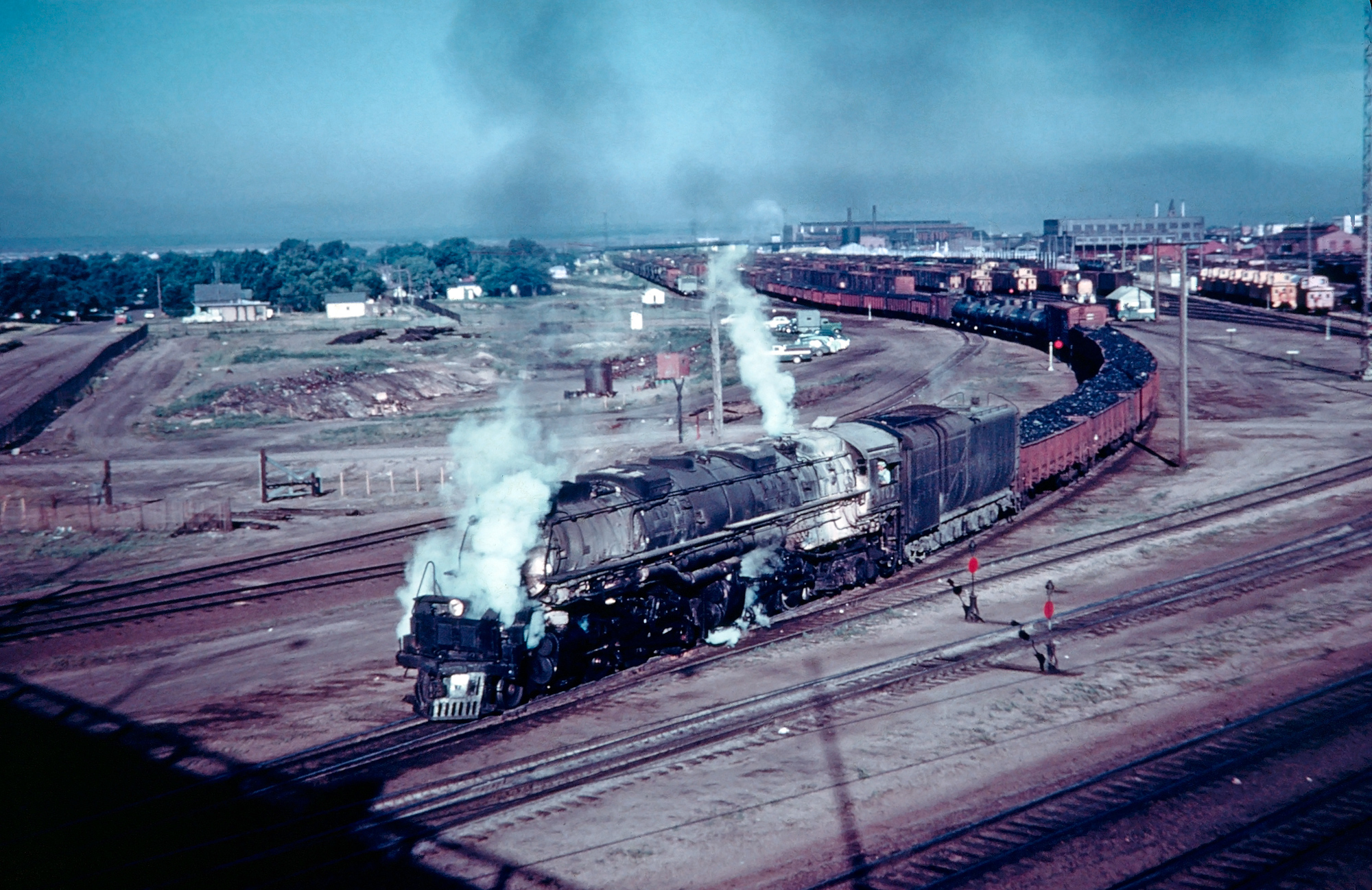 Union Pacific 4-6-6-4 #3702 in Cheyenne, Wyoming, circa 1958. This locomotive was formerly #3932 and converted to an oil burner in 1952. Richard Wallin photo. American-Rails.com collection.
Union Pacific 4-6-6-4 #3702 in Cheyenne, Wyoming, circa 1958. This locomotive was formerly #3932 and converted to an oil burner in 1952. Richard Wallin photo. American-Rails.com collection.Originally deployed on the Wasatch route, the Challengers were repositioned after the introduction of the more powerful Big Boys.
UP, recognizing the versatility of the engines, effectively employed the locomotives across its expansive network—from the rugged terrains of Oregon and California to the vast landscapes of Utah and Wyoming.
The utilitarian value of the 4-6-6-4s extended beyond Union Pacific as the eight other buyers of this model leveraged them for hauling heavy freights across steep grades.
Of the 252 Challengers constructed, the majority were manufactured by the American Locomotive Company (Alco), with Baldwin Locomotive Works contributing 27 units to the total fleet.
Railroads
Delaware & Hudson
Delaware & Hudson's 4-6-6-4s were a series of simple articulated locomotives designed for freight service as the railroad sought greater overhead bridge traffic
Built by the American Locomotive Company, the beautiful engines were known for their power and efficiency, and used extensively in handling fast freights although the D&H network.
Unfortunately, the big Challengers saw only a decade of service before their retirement came due to newly arriving diesels, predominanetly in the form of RS2s and RS3s.
The diesels were not as powerful but could be utilized in a range of different applications, from main line work to branch duties. This greater redundancy no doubt led to Challengers' quick retirement by the early 1950s. Alas, none of these fine machines were preserved.
The D&H was a prominent rail system that emerged in the nineteenth century, and its fleet of 4-6-6-4 steam locomotives carried significant weight in the history of American railroading.
In his book, "Delaware & Hudson: The Bridge Line to New England and Canada," author Jim Shaughnessy notes the railroad's long-profitable anthracite coal business was drying up by the 1930s.
The rock had been used for decades heating residential and commercial buildings thanks to its clean burning properties. However, with the rise in electricity and oil-fed furnances railroads which had relied on anthracite - names like the D&H, Lackawanna, Lehigh & New England, Lehigh Valley, and others - were forced to find other freight to offset this declining business.
Joseph Nuelle, elected president of the D&H on May 16, 1938, was tasked with doing just that. His answer involved greatly increasing the railroad's bridge traffic between Canada and New England, especially its connection with the Boston & Maine at Mechanicville, New York.
To do this involved faster and more powerful steam locomotives. The company's reliable but aging fleets of 2-8-0s were simply not able to handle heavy freights at high speed.
As a result, Nuell placed an order for 20 new 4-6-6-4s from American Locomotive in 1940. The D&H's Challengers were mammoth machines, which have also been described as one of the most beautiful large articulated designs ever built.
Known officially as Class J, the locomotives were D&H's most imposing and versatile locomotives. They boasted clean lines with a sleek, smooth boiler, white trim, white-wall wheels, short pilot, and centered bell on the smokebox. The company was so-proud of these engines, #1501 was placed on public display at Albany, New York following its delivery.
This initial roster, #1500-1519, had cost $178,900 each for a total price tag of $3,578,000. The engines were fine machines and lived up to their billing; they could either hustle fast freights at speeds of 50 mph or work helper assignments on the Penn Division.
Nuelle's efforts proved a resounding success as the D&H's interchange traffic at Mechanicville increased by 43.7% between 1940-1941. In addition, similar business at Rouses Point, New York jumped by a staggering 263.8% during the same period.
The great influx of freight traffic - which increased once the U.S. became involved in the global conflict - convinced Nuelle to order 15 more Challengers from Alco in 1942. The price of this group increased to $213,500 per locomotive.
Each engine, with its accompanying tender, weighed a staggering 987,00 pounds. They were equipped with roller bearings on all axles, including the rods to lower the maintenance needs and facilitate smoother operation. The boiler pressure was adjusted to 265 pounds per square inch, driving the 69-inch wheels at a starting tractive effort of 94,000 lbs.
These locomotives came with a large tender capable of carrying 22,500 gallons of water and 26 tons of coal. They were geared for 60-70 mph operation and it is said these Challengers were the most stable, and smoothest riding, big articulateds ever built. The Class Js, despite their imposing size and power, were lauded for their speed, flexibility, and reliability.
Interestingly, despite recognizing the diesel's potential, the D&H continued ordering more Challengers through the mid-1940s. Between 1945-1946 it acquired its last final five, #1535-1539, at a cost of $1,125,000.
The final engine, #1539, was noteworthy as featuring a welded boiler, a design pioneered by the D&H itself on 2-8-0 #1219 in 1937. Despite their illustrious performance, the Challengers' service life was quite short due to the advent of diesel-electric technology.
The D&H purchased its first 1,500 RS2s for general road service in 1946, acquiring more RS2s throughout that decade, and RS3s through the 1950s.
By then, diesels were universally accepted by both the D&H - and the industry in general - as the more cost-effective and efficient locomotive. As a consequence, the fleet of 4-6-6-4s, like other steam giants, was gradually phased out.
Between 1952-1953, all of the Class Js were retired, bringing an end to the age of steam glory on the D&H system. Incredibly, the last five enjoyed only a few years of service before they were scrapped!
Specifications
Today, while none of D&H's 4-6-6-4s survive, two similar locomotives from the Union Pacific are extant; #3985 and #3977, providing a tangible example of this colossal wheel arrangement.
Likewise, the memory and significance of D&H's Challengers live on through historical documentation, photographs, and the indomitable spirit of rail enthusiasts and historians worldwide.
In the annals of the Delaware & Hudson, the 4-6-6-4 Challengers hold a special place. They were not just engines but monumental innovations symbolizing an age of unfettered industrial progress and engineering prowess.
Their legacy remains a testament to the prime of American railroading, serving as an enduring symbol of a time when steam giants ruled the rails.
Western Maryland
Western Maryland's big 4-6-6-4s were a radical departure from anything the railroad had rostered up until that time. Like all Challengers, the big brutes were designed for fast freight service.
The railroad had long been known for redundancy within its locomotive fleet. Management continually sought a versatile engine capable of navigating both the challenging mountain terrains and the Potomac Valley's more forgiving profile between Hagerstown and Cumberland.
However, the Challengers were not heavy drag service engines although the railroad occasionally employed them in helper assignments. As a result, the WM's feelings on the 4-6-6-4s are historically mixed.
Despite this, they were reliable machines and lived up to the railroad's slogan, "Fast Freight Service." Unfortunately, all were scrapped in the mid-1950s. From a corporate standpoint, and railfan perspective, the fast Challengers are also noteworthy for introducing the WM's now-famous "Fireball" herald when the first examples rolled out of Baldwin's Eddsytone plant in 1940.
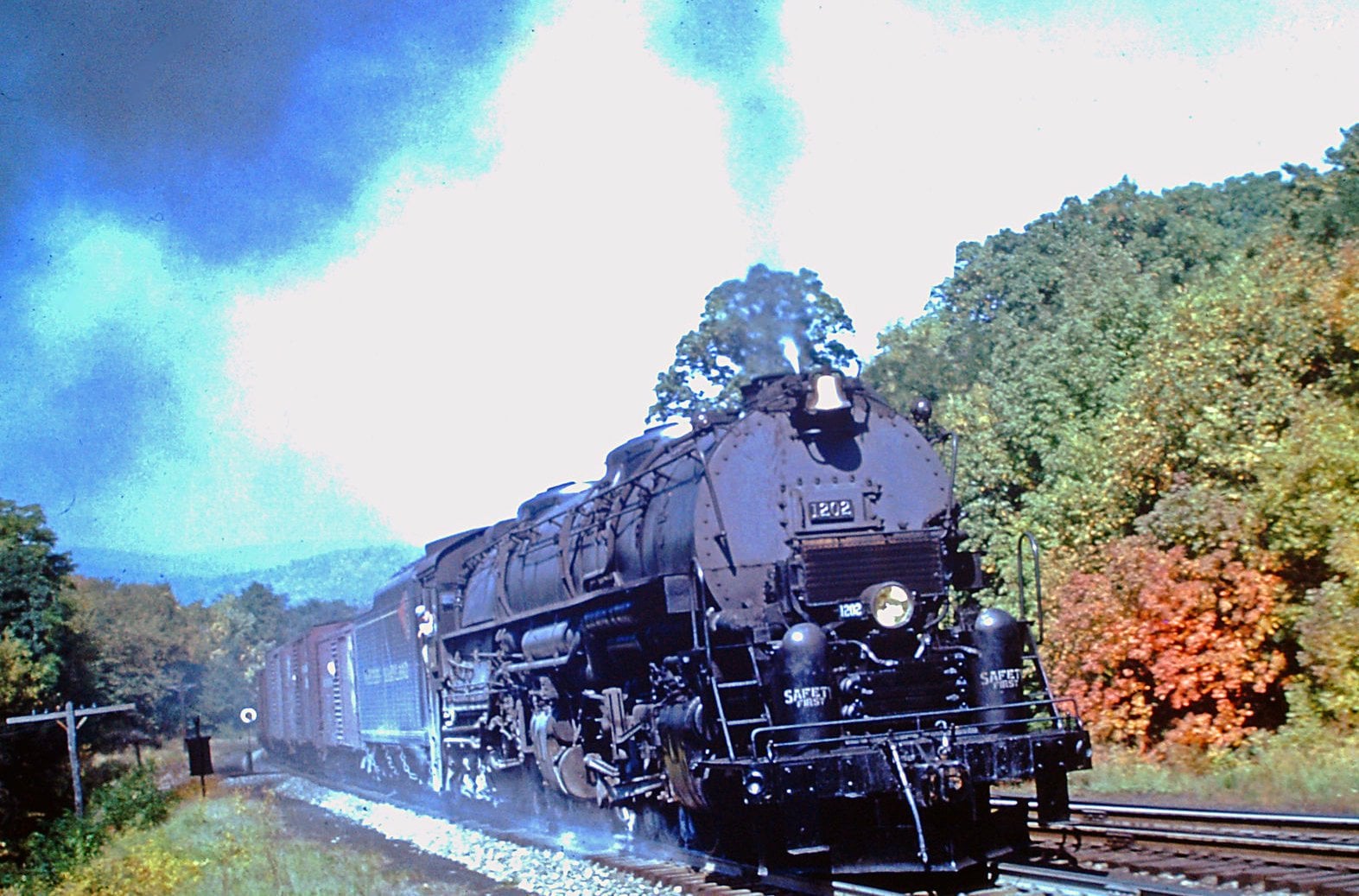 Western Maryland 4-6-6-4 #1202 (M-2) hustles a freight train through Frostburg, Maryland on October 1, 1952. These powerful 'Challengers' were designed for fast freight service between Hagerstown, MD-Connellsville, PA although a number of issues resulted in their banishment east of Cumberland. All were scrapped in 1953.
Western Maryland 4-6-6-4 #1202 (M-2) hustles a freight train through Frostburg, Maryland on October 1, 1952. These powerful 'Challengers' were designed for fast freight service between Hagerstown, MD-Connellsville, PA although a number of issues resulted in their banishment east of Cumberland. All were scrapped in 1953.The mid-20th century was a transformative period for American railroads, with increasing demands for freight transportation and the need for more powerful locomotives to handle mountainous terrains and longer, heavier trains.
The Western Maryland, facing these operational challenges, sought out a solution that would both meet capacity demands and improve efficiency on its steep gradients and winding routes.
In response to these needs, the WM acquired twelve 4-6-6-4s from the Baldwin Locomotive Works between 1940-1941. These were designated as Class M-2, numbered 1201-1212. The Challengers were based on an articulated design originally developed by the Union Pacific but adapted to suit the specific requirements of the WM.
A handful of other Class 1s also operated examples of this type including the Clinchfield; Delaware & Hudson; Denver & Rio Grande Western; Great Northern; Northern Pacific; Spokane, Portland & Seattle; and Western Pacific.
WM's Challengers were a late era design, incorporating many of the advanced "Super Power" concepts which had been established during the 1920s. Despite their relatively short operational period, the 4-6-6-4s left a lasting mark on WM’s operations, embodying the zenith of steam locomotive development.
Specifications
| Class | M-2 |
| Railroad | Western Maryland (WM) |
| Whyte | 4-6-6-4 |
| Number in Class | 12 |
| Road Numbers | 1201-1212 |
| Gauge | Std |
| Number Built | 12 |
| Builder | Baldwin |
| Year | 1940 |
| Valve Gear | Walschaert |
| Locomotive Length and Weight | |
| Driver Wheelbase | 24 Feet |
| Engine Wheelbase | 60 Feet, 3 24/25 Inches |
| Overall Wheelbase | 106 Feet |
| Axle Loading (Maximum Weight per Axle) | 67,562 Lbs |
| Weight on Drivers | 402,266 Lbs |
| Engine Weight | 601,000 Lbs |
| Tender Loaded Weight | 418,950 Lbs |
| Total Engine and Tender Weight | 1,019,950 Lbs |
| Tender Water Capacity | 22,000 Gallons |
| Tender Fuel Capacity | 27 Tons |
| Minimum weight of rail (Lbs/Yard) | 112 |
| Driver Diameter (Inches) | 69 |
| Boiler Pressure (psi) | 250 |
| High Pressure Cylinders (Diameter x Sstroke) | 22" x 32" |
| Tractive Effort | 95,397 Lbs |
| Factor of Adhesion (Weight on Drivers/Tractive Effort) | 4.22 |
| Firebox Area (Square Feet) | 796 |
| Grate Area (Square Feet) | 118.80 |
Production Roster
| Class | Road Numbers | Completion Dates | Notes |
|---|---|---|---|
| M-2 | 1201-1206 | 1940 | Scrapped in 1953. |
| M-2 | 1207-1212 | 1941 | Scrapped in 1953. |
WM's Challengers are a subject that often invites a range of strong opinions among rail enthusiasts and historians. A common misconception is that these locomotives were solely used as helpers and not as mainline fast freight engines. However, this overlooks their pivotal role from their delivery until the arrival of the 4-8-4s in January 1947.
Initially, the 1200-series were indeed deployed as mainline freight engines, fulfilling their intended purpose of running through trains from Hagerstown to Connellsville. Freight trains on this route operated at a maximum speed of 50 mph between Hagerstown and Cumberland, and 45 mph between Cumberland and Connellsville.
Occasionally, the Challengers extended their reach by working trains east of Hagerstown towards Baltimore. However, the hilly and curving mainline, with speed limits restricted to 40 mph, made this territory less suited to their strengths.
With the introduction of the 4-8-4s, the operational landscape changed, and the Challengers were primarily confined west of Cumberland.
Most trips east of Cumberland, likely for maintenance at the Hagerstown shops, became infrequent. Predominantly, the 1200-series worked the "New Line" (Connellsville Extension), often serving as helpers. This role was not unique to the Challengers, as nearly every type of motive power on the WM offered assistance on critical grades like Sand Patch.
On the WM, there were no divisions without a helper district, showcasing the railroad's proficiency in utilizing power as helpers. For trains navigating Sand Patch, mid-train and rear-end helpers were common. Some helpers on westbound trains would either stay with the train to Connellsville or decouple and follow the train independently.
Notably, there were instances where a rear-end helper, shoving on a caboose, had another engine trailing behind the tender. This setup indicated that the crew would continue to Connellsville and return with another train eastbound.
Such operations often saw the pairing of older Decapods as head-end locomotives with Challengers providing rear-end assistance, highlighting the interchangeable use of these powerful engines in such assignments.
It seems WM's train crews had mixed opinions of these big articulateds. Some found these locomotives to be rough-riding, although such comparisons were often made against the Pacifics and Potomacs, the latter being WM's moniker for their 4-8-4s.
Others criticized the 4-6-6-4s for being slippery, while a skilled few argued that they simply required a knowledgeable touch to operate effectively.
The 4-6-6-4s had potential avenues for improvement, predominantely the inclusion of roller bearings on all axles. The railroad's initial foray into this technology was with the lead truck only on #1200, a somewhat unusual investment in 1940 when such bearings were primarily reserved for passenger locomotives.
Many smaller Challengers at the time also used solid bearings. Incorporating Type E superheaters, as later seen in the 4-8-4s, could have markedly boosted the efficiency of the 1200-series. However, no clear application of Type Es is evident in WM's 4-6-6-4s. Their superheater heating area was comparable to other engines but smaller than that of the later 1400-series.
Higher steam pressure could have resulted in greater power and reduced fuel consumption. Additionally, trailing truck boosters would have enhanced their low-speed capabilities.
Had Baldwin inncorporated certain design elements from Alco, such as the new weight-supporting hinge, these engines might have had better weight distribution and improved ride quality. Nevertheless, these advancements, excluding the roller bearings, would have increased maintenance costs.
The WM seemed perpetually unsatisfied with their Challengers. It's unclear if they fully grasped the design intentions of these powerful machines. If their goal was to accelerate fast freight operations, the Challengers did indeed provide that capability.
It has been argued the railroad would have been better served by 2-8-8-4s, which were later acquired by the Baltimore & Ohio. The B&O's EM-1s, which offered roughly 20,000 pounds more starting tractive effort, were fine machines and arguably the best large articulateds the railroad ever owned.
In fact, despite wanting diesels at the time, the B&O became quite fond of its Yellowstones and they remained in service until the latter 1950s.
For the WM's part, the subsequent arrival of the 4-8-4s demonstrated that the same trains could be managed more efficiently over flatter terrain with smaller engines. Train speeds, however, were impacted by frequent stops required to couple on mid-train and rear-end helpers for tackling the Sand Patch.
Ultimately, management concluded that in mountainous territory, tractive effort outweighed horsepower in importance—a decision that proved accurate for their operational needs.
While the M-2s had a relatively short operational life, their legacy endures in the annals of American railroading history. These locomotives represented the peak of steam technology and the determination of the Western Maryland to overcome challenging operational conditions.
Sadly, none of the 4-6-6-4s were preserved. However, their memory is kept alive through photographs, documentation, and the stories of those who witnessed their might along the mountainous routes of the Western Maryland.
Railway enthusiasts and historians continue to celebrate the legacy of the Western Maryland Railway and its iconic Challengers. Models, literature, and historical accounts serve to preserve the rich heritage of these locomotives, reminding us of the pivotal role they played in the railroad’s operational history.
The M-2s were more than just machines; they were embodiments of the technological advancements and operational challenges of mid-20th century American railroading.
These powerful locomotives exemplified the peak of steam locomotive design, capable of navigating the steep grades and heavy loads characteristic of the WM's rugged routes.
Despite their brief period of operation, the Challengers left a lasting impression on the Western Maryland and its surrounding communities. Their presence marked a significant era in the history of rail transport, reflecting the broader transitions and innovations within the industry.
The story of the WM's Challengers is a testament to the ingenuity and resilience of the railway and its workforce, forever etched in the legacy of American railroads.
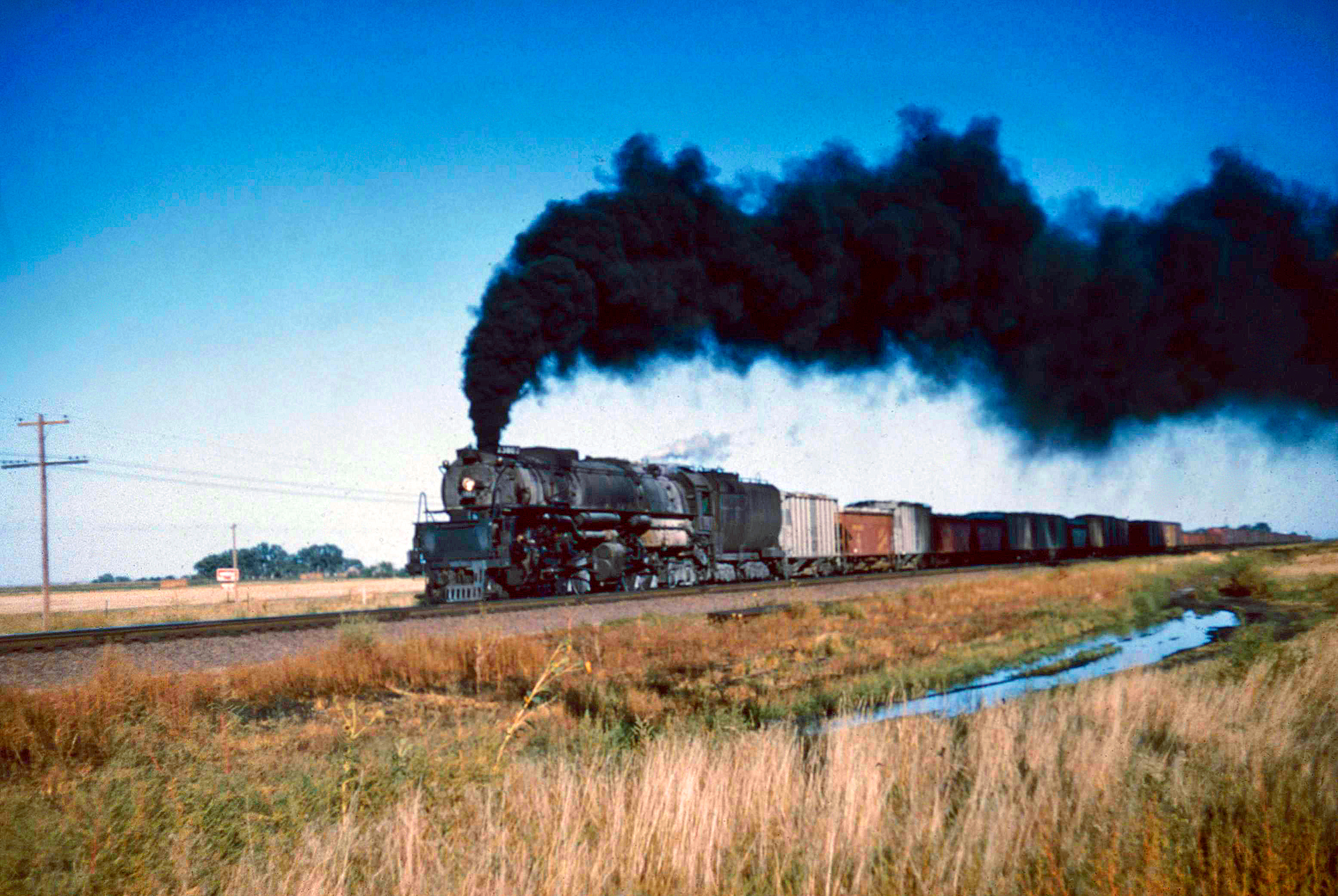 Union Pacific 4-6-6-4 #3802 hustles a long freight westbound near Lexington, Nebraska on September 15, 1950. American-Rails.com collection.
Union Pacific 4-6-6-4 #3802 hustles a long freight westbound near Lexington, Nebraska on September 15, 1950. American-Rails.com collection.Preservation
Of all the Challengers built, astonishingly only two remain preserved; Union Pacific #3985 and #3977. In addition, former Delaware & Hudson 1508's tender remains.
#3977 has been on display for many years in North Platte, Nebraska while #3985 operated as part of the Class I's steam program from 1981 until 2011.
Since that time it has awaited a major overhaul, which never came following the restoration of 4-8-8-4 #4014. It was announced in January, 2020 (retroactive to May, 2019) that #3985 was permanently retired.
In 2022 the big Challenger was donated to the Railroading Heritage of Midwest America, the major non-profit organization based in the old Rock Island shops in Silvis, Illinois. The organization plans to fully overhaul the locomotive and operate it in excursion service.
Today, along with sister #844, #4014 regularly chugs along the UP system on excursions and other promotional events. The Big Boy's phenomenal success in 2019 means it will be play a significant part in UP's steam program and public relations events moving forward.
If you have the opportunity I strongly recommend seeing one (or both) of these old girls in action, as large steam locomotives operating at-speed on main line railroads today is extremely rare.
Sources
- Griffin, James R. Rio Grande Railroad. St. Paul: Voyageur Press, 2003.
- Solomon, Brian. Baldwin Locomotives. Minneapolis: Voyageur Press, 2009.
- Solomon, Brian. Alco Locomotives. Minneapolis: Voyageur Press, 2009.
- Welsh, Joe and Holland, Kevin. Union Pacific Railroad. Minneapolis: Voyageur Press, 2009.
Contents
Recent Articles
-
Louisville and Indiana Railroad: Maintaining The PRR In The Midwest
Jan 21, 25 06:08 PM
The Louisville & Indiana operates 106 miles of the former PRR's main line between Indianapolis and Louisville. The short line has been in operation since 1994. -
SunRail: Connecting The Greater Orlando Region
Jan 21, 25 05:57 PM
SunRail was launched in 2014 to provide commuter rail service within the greater Orlando, Florida region operating over CSX tracks. It currently hosts more than 1 million riders annually. -
Urban Rail Expansion: New Projects On The Horizon
Jan 21, 25 04:34 PM
This article briefly looks at urban rail projects either under construction or in the planning stages at various cities throughout the country.

